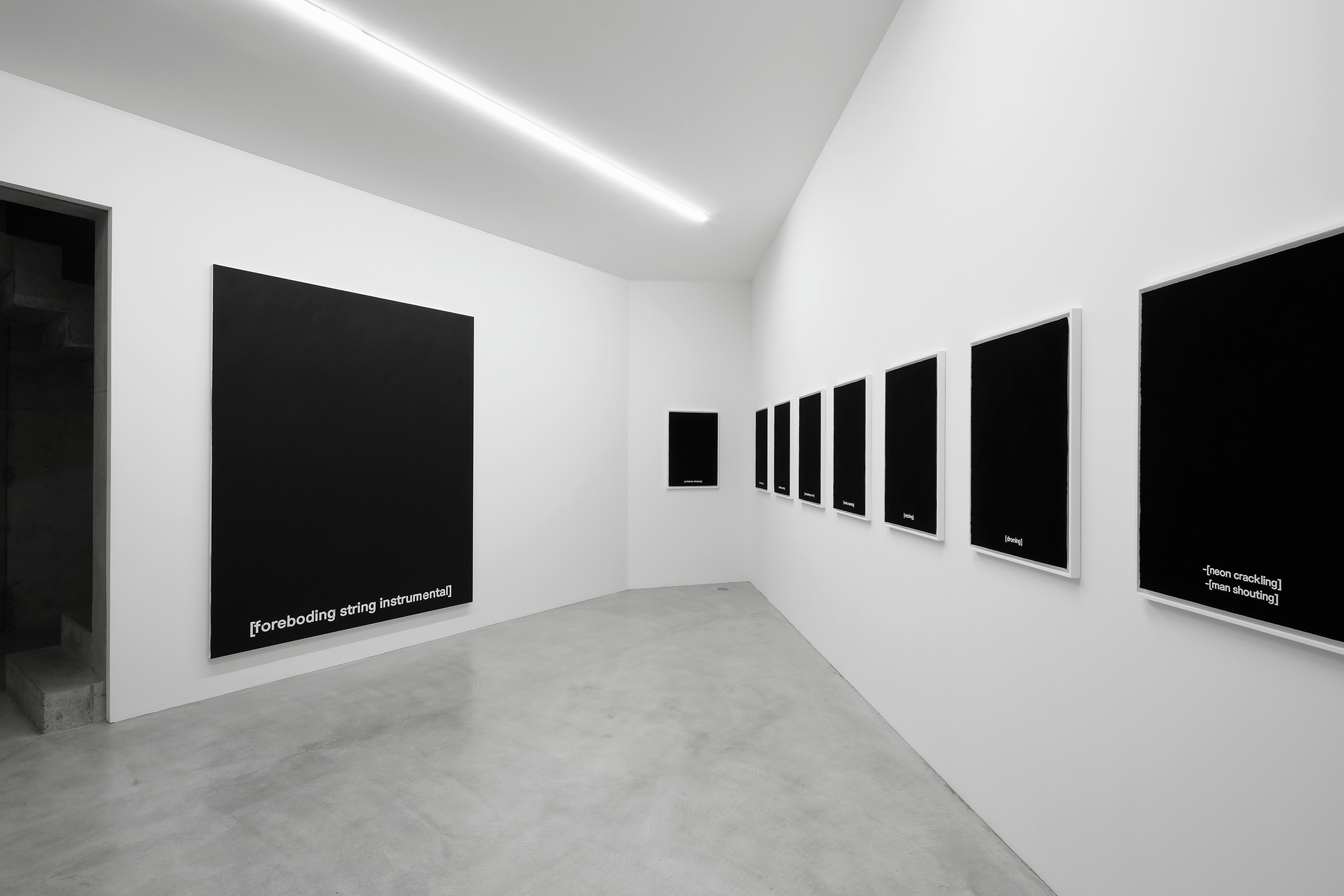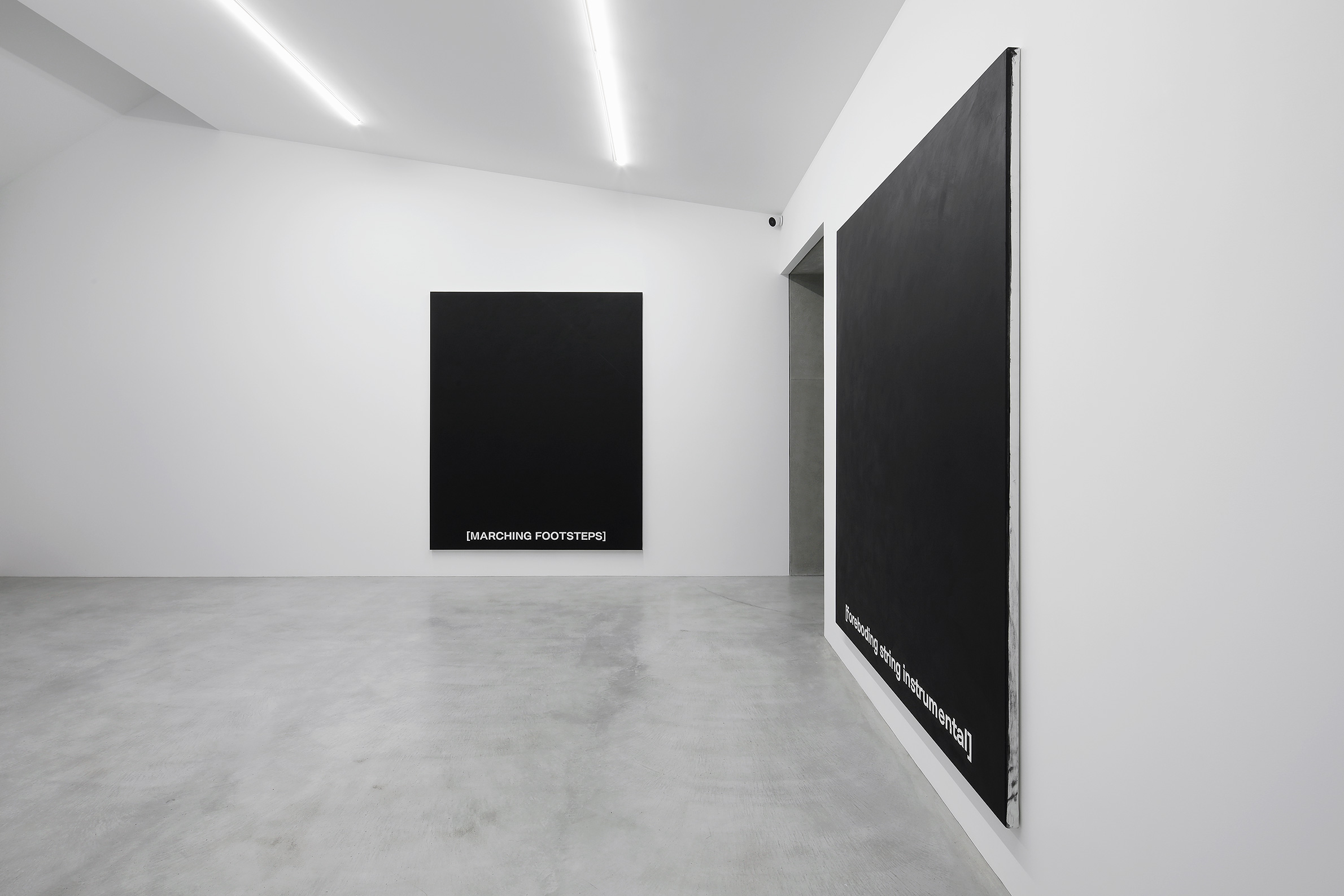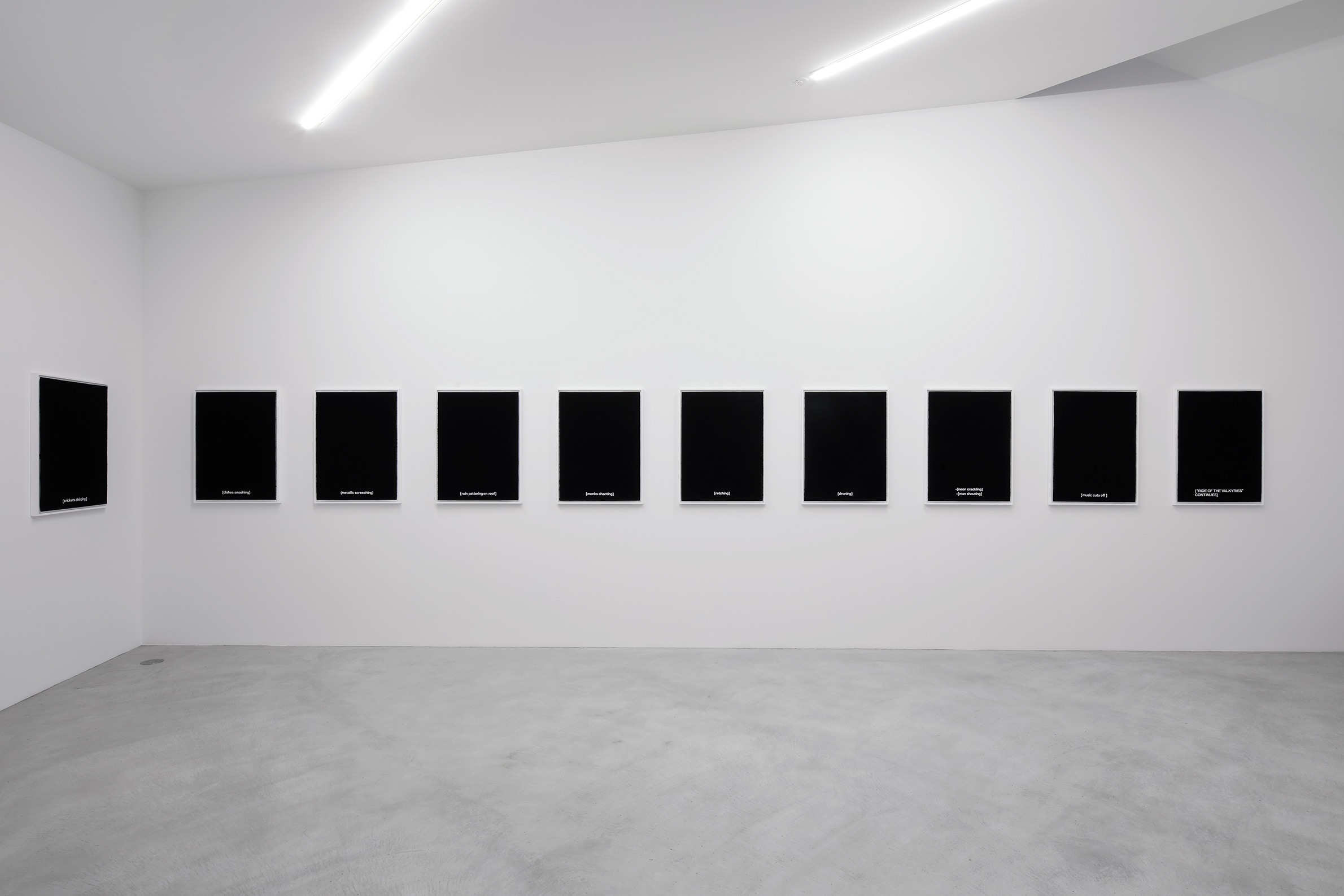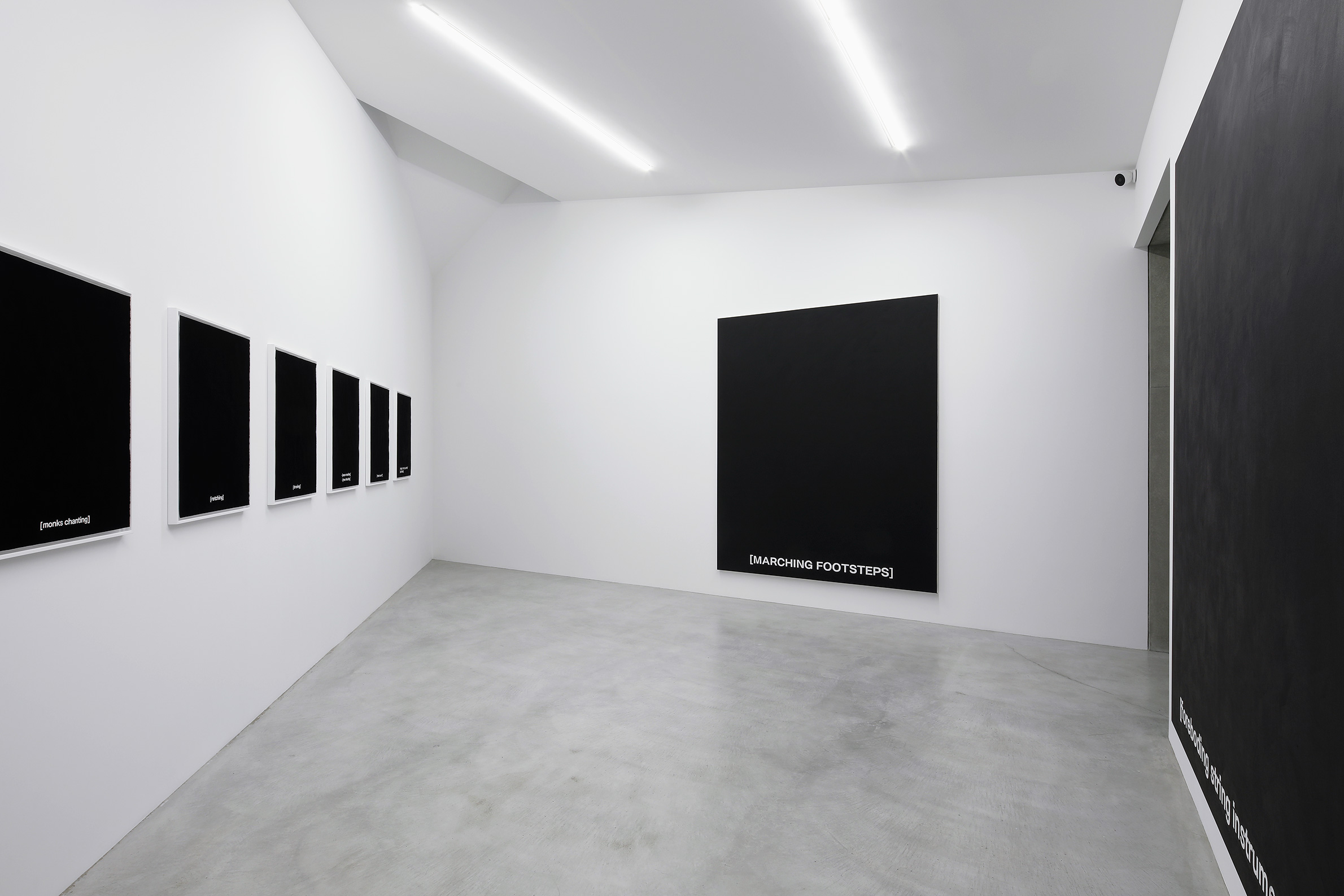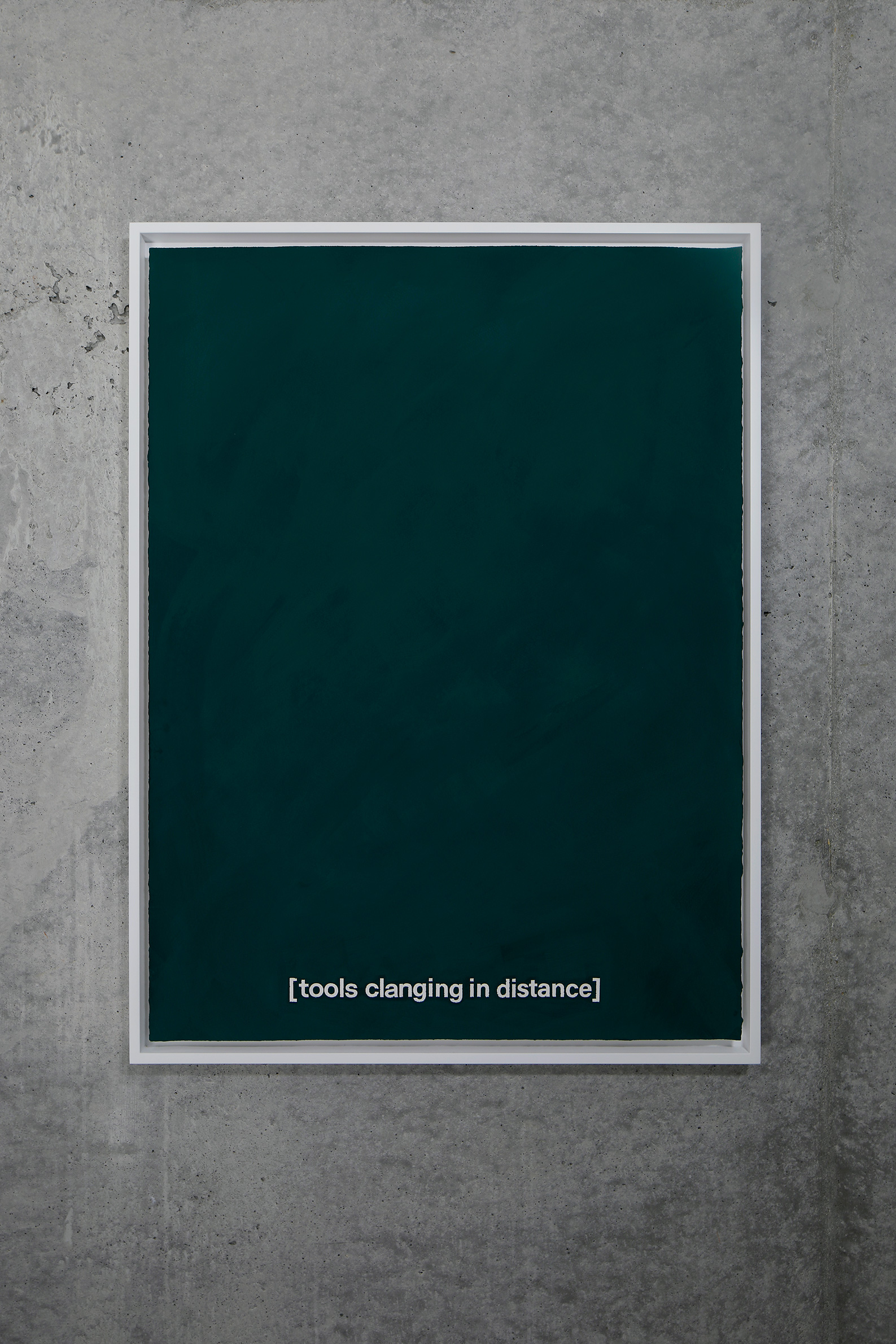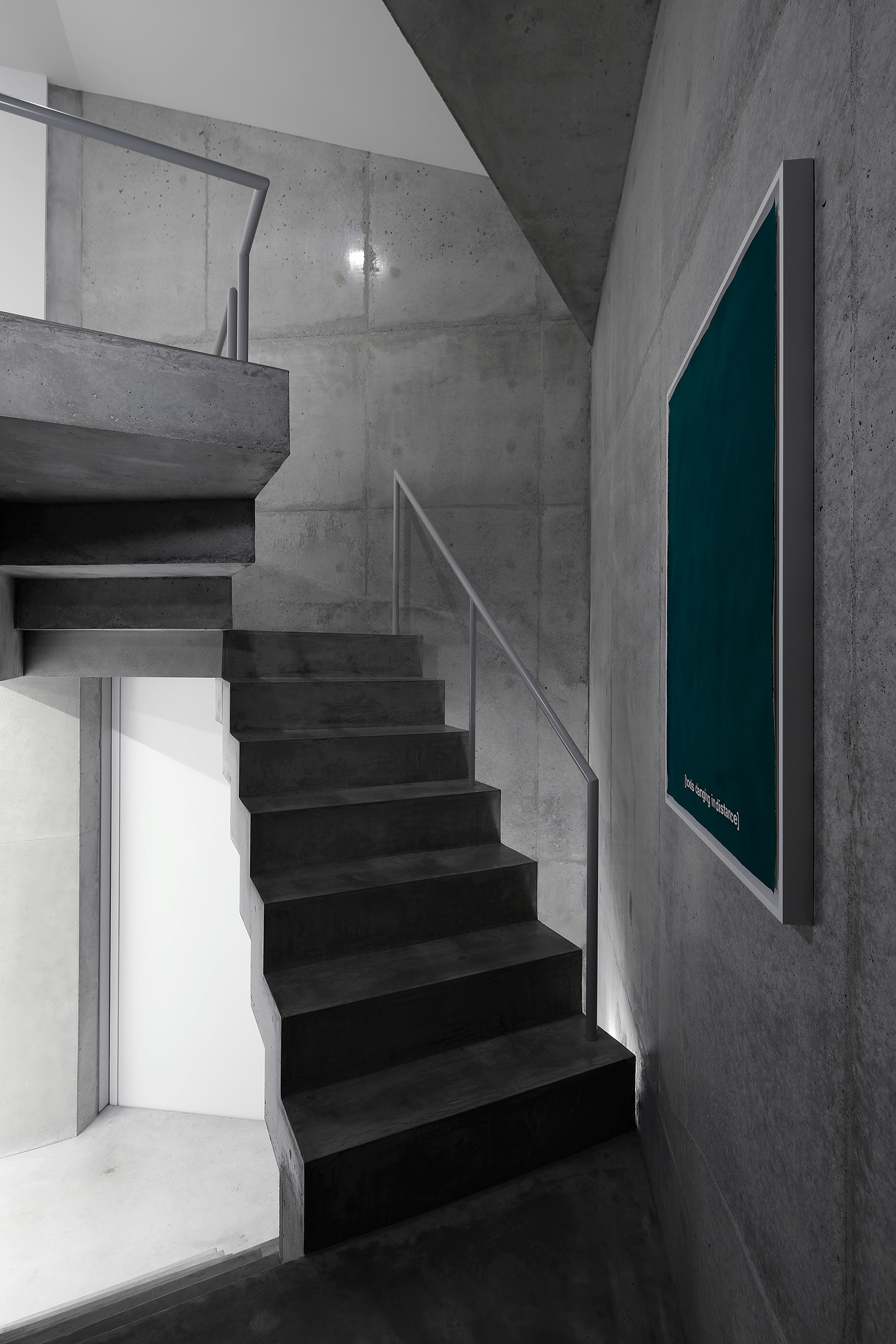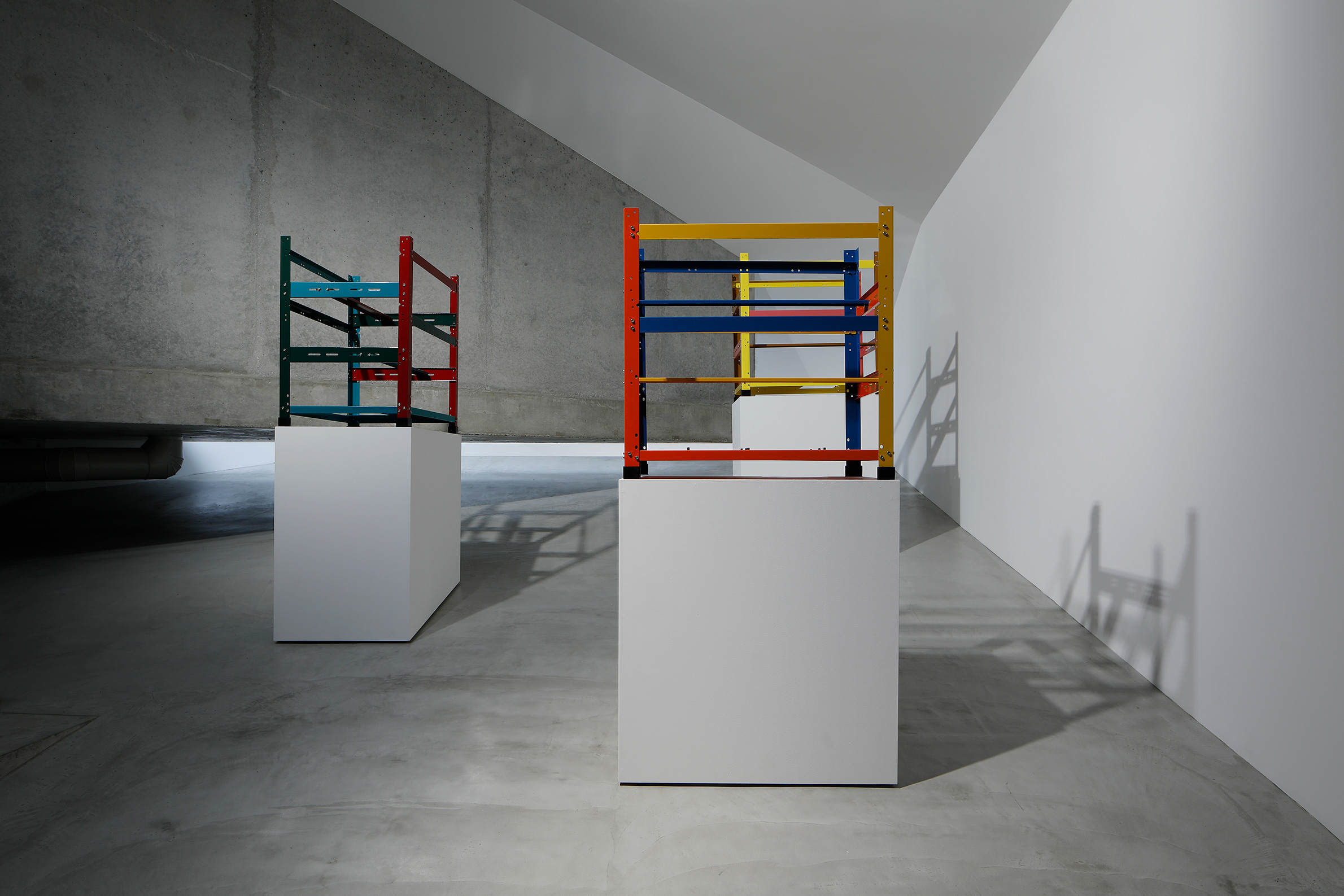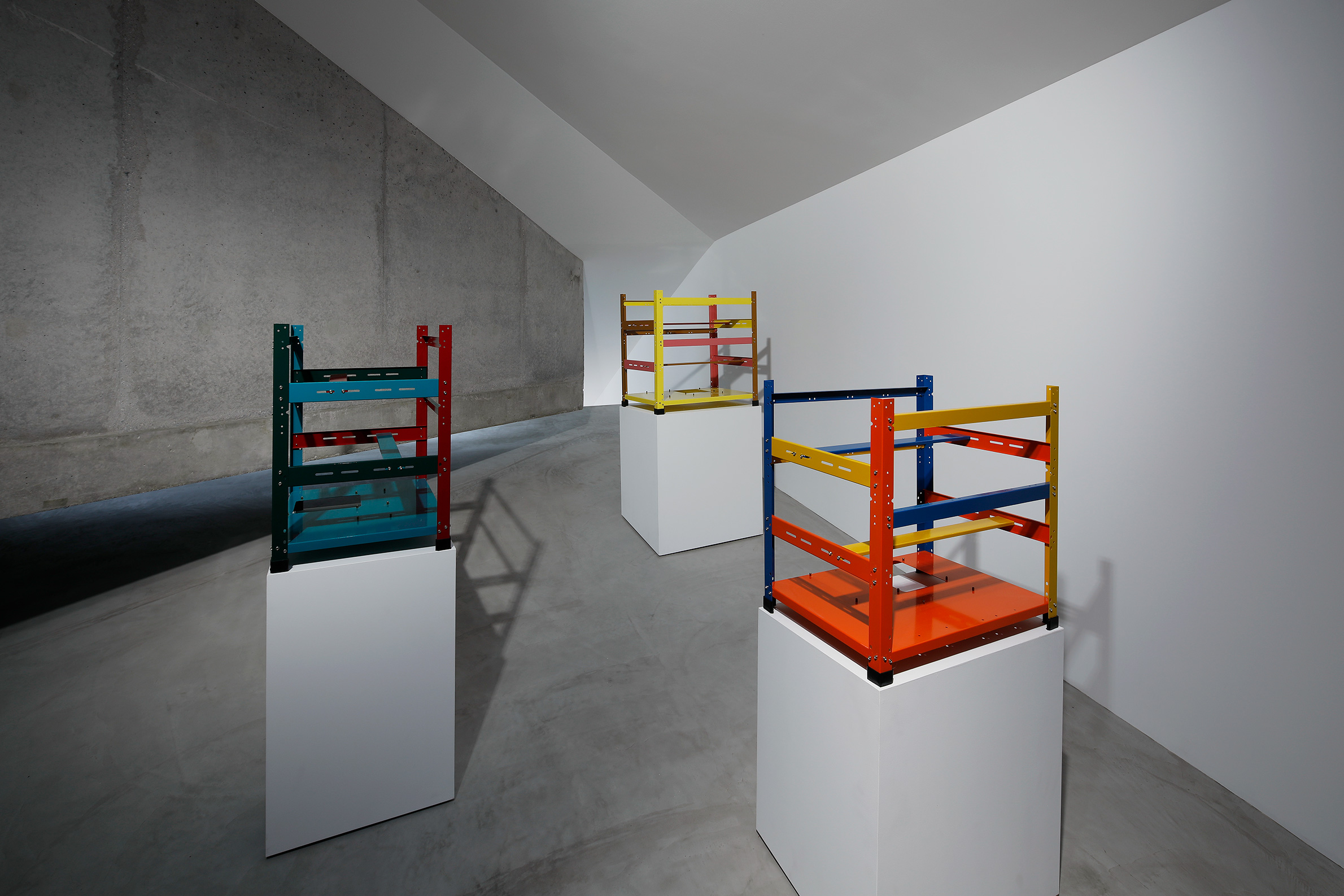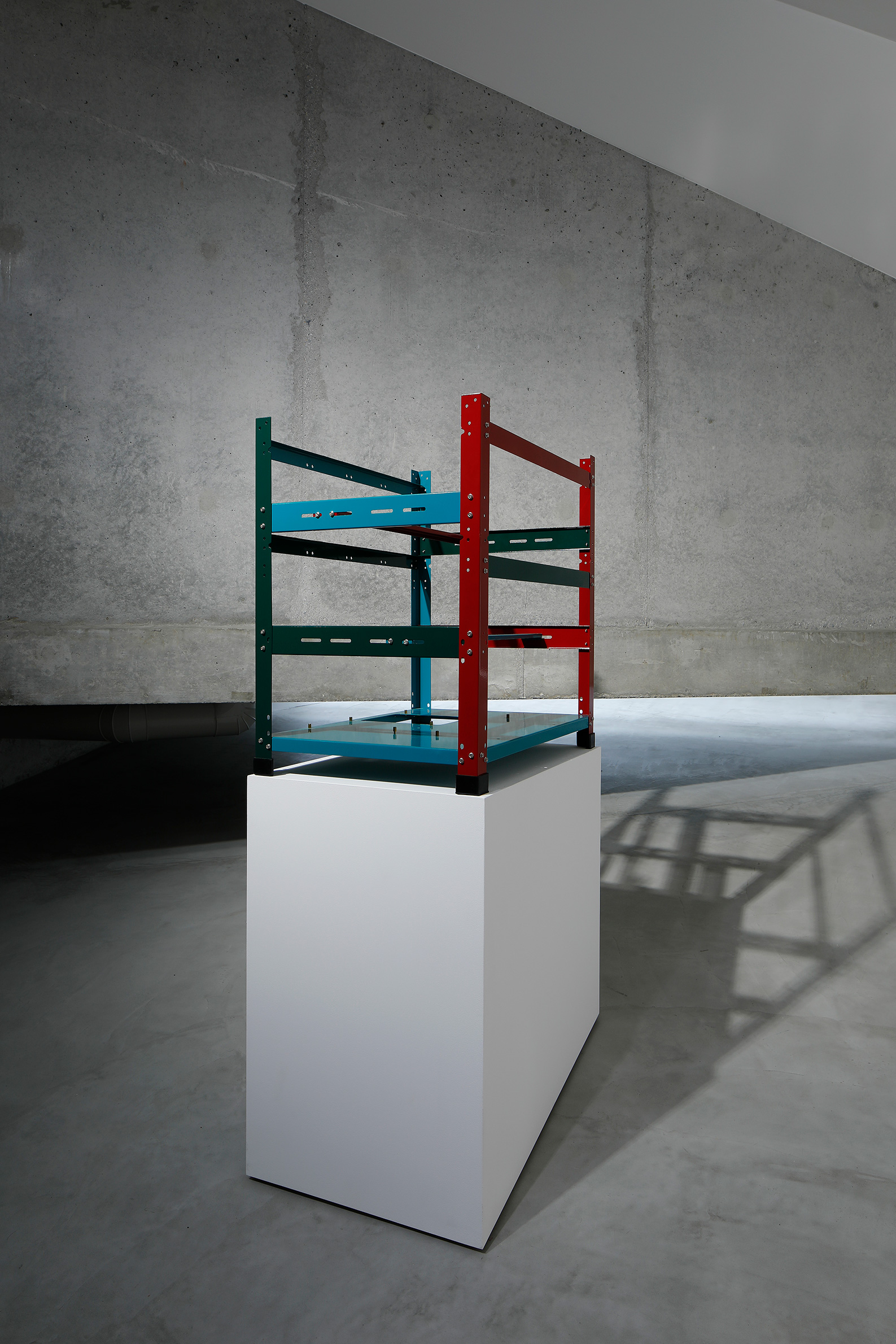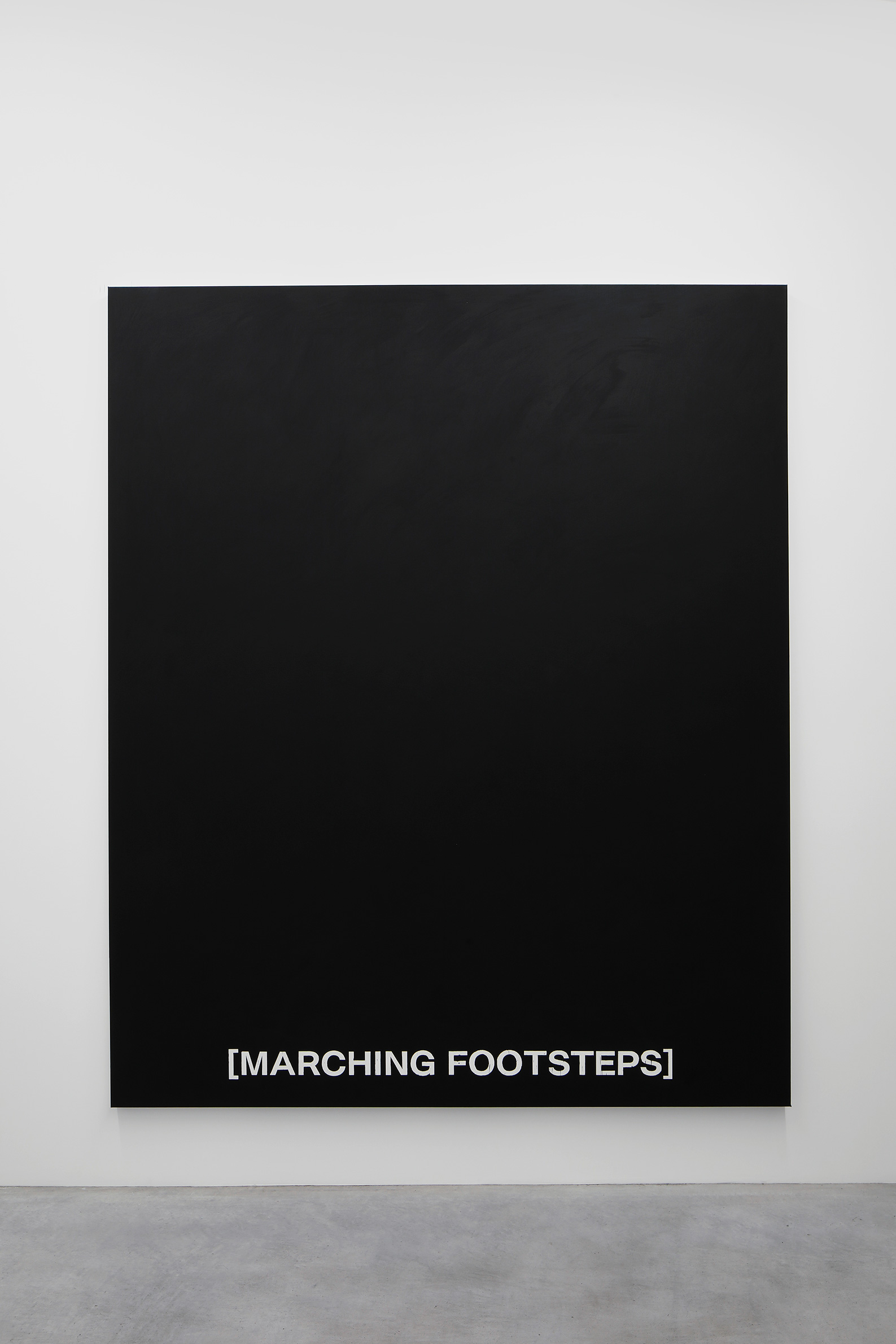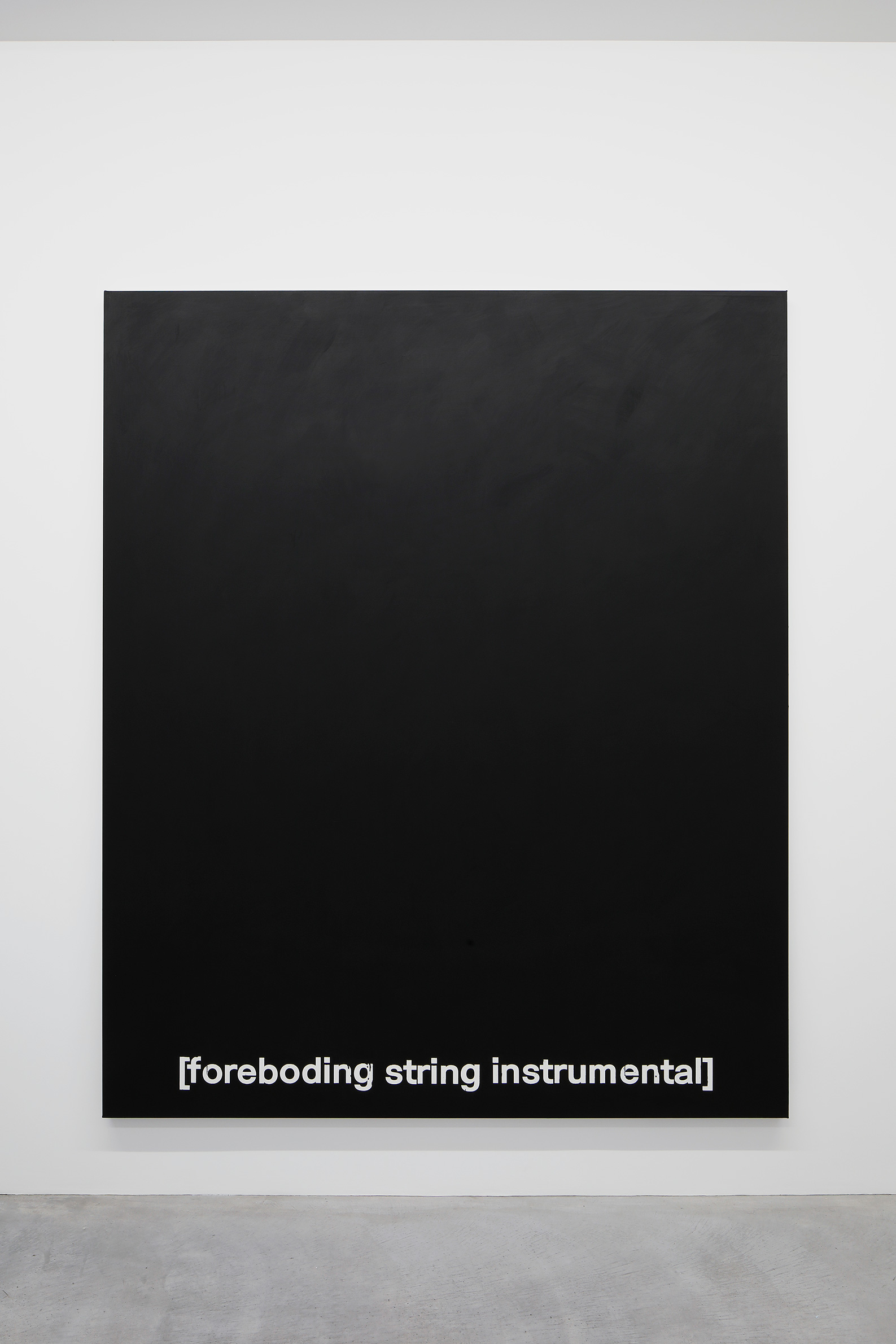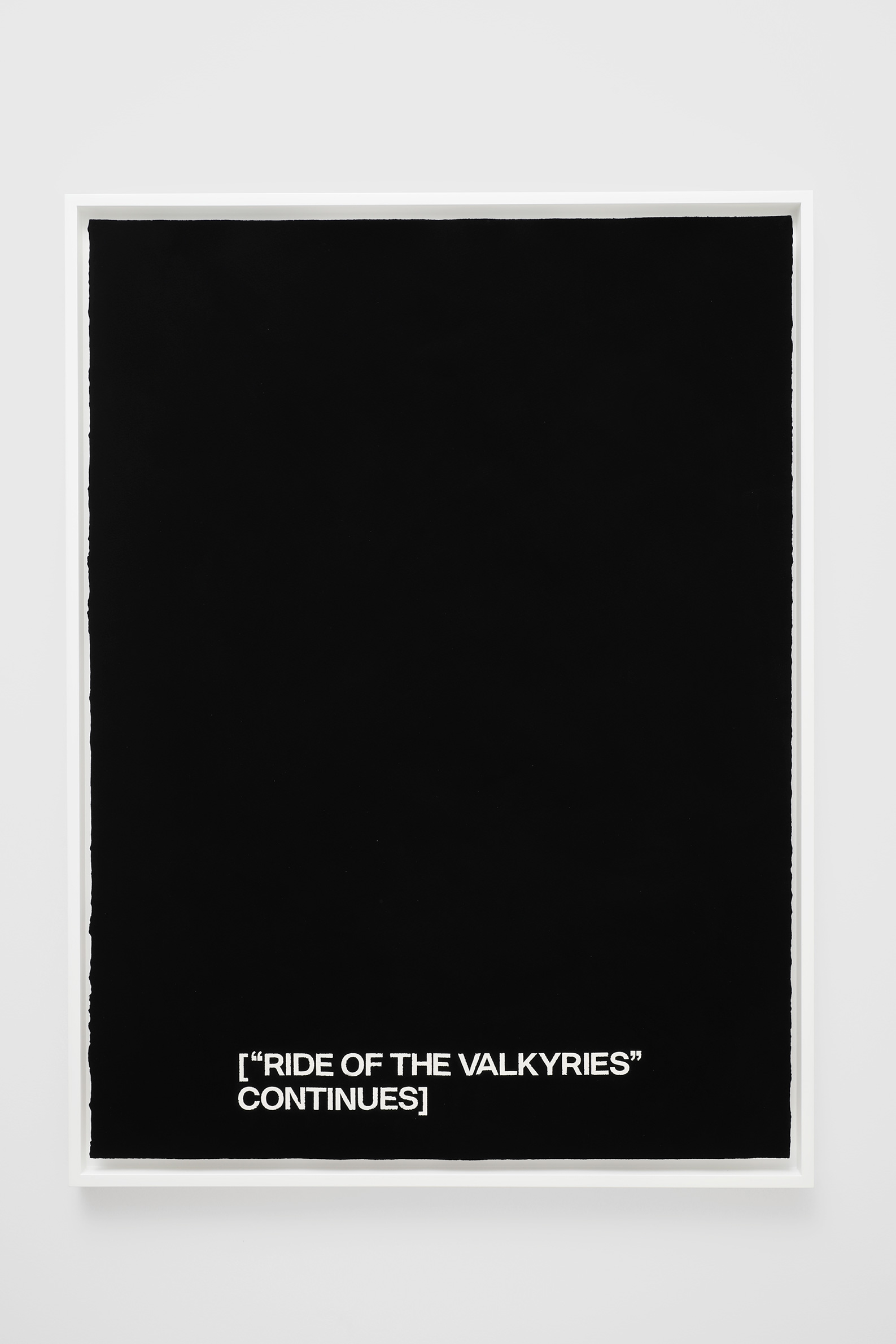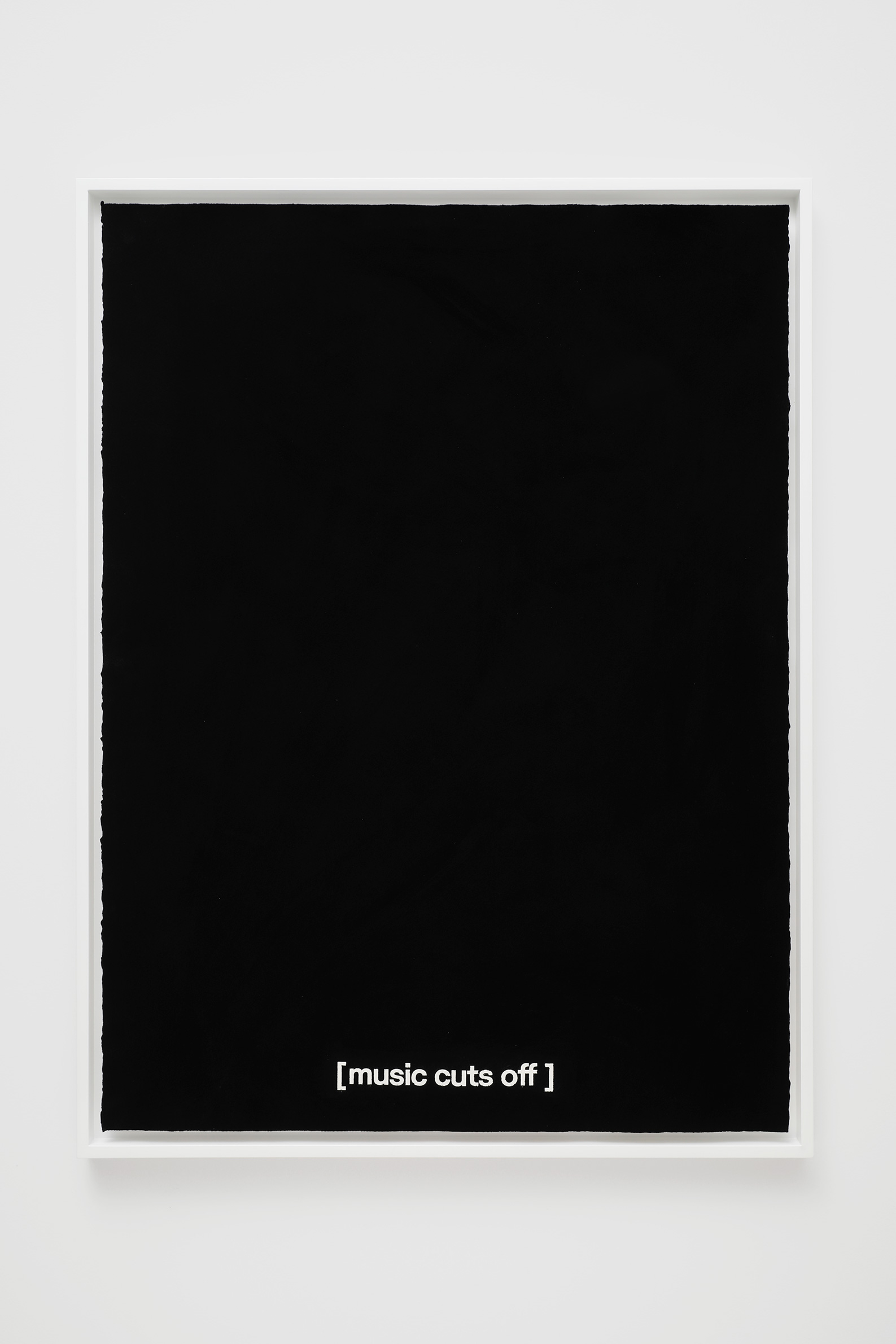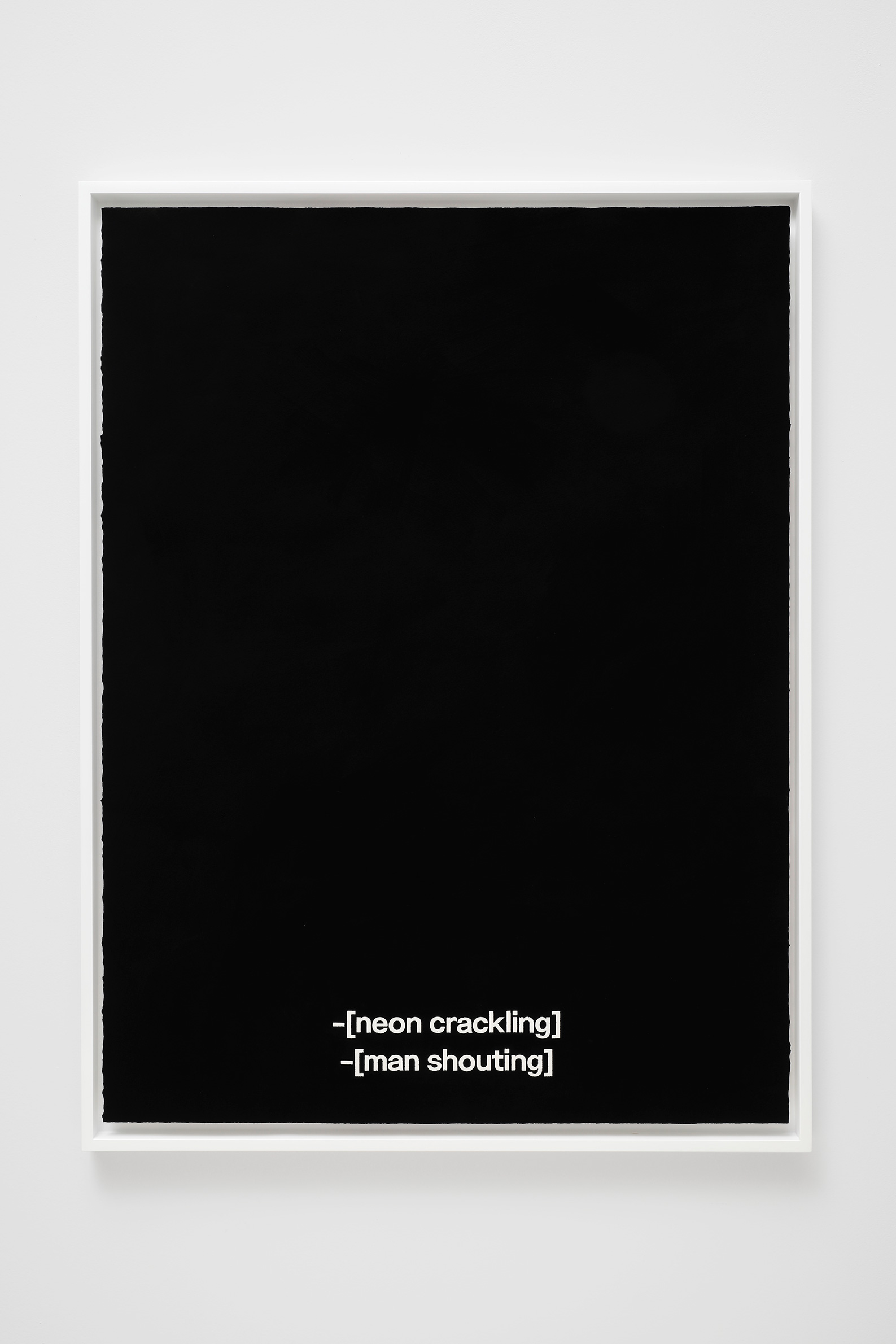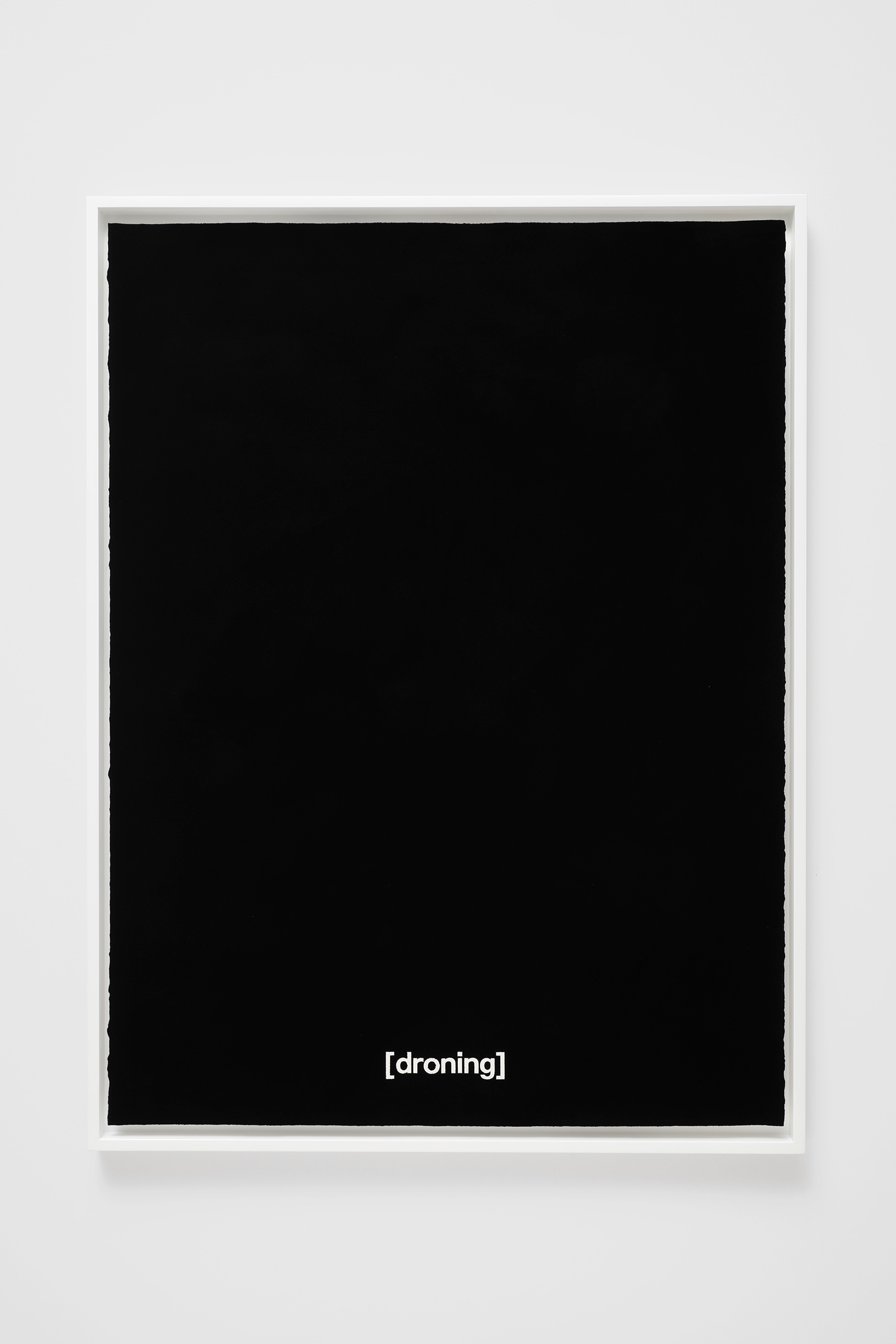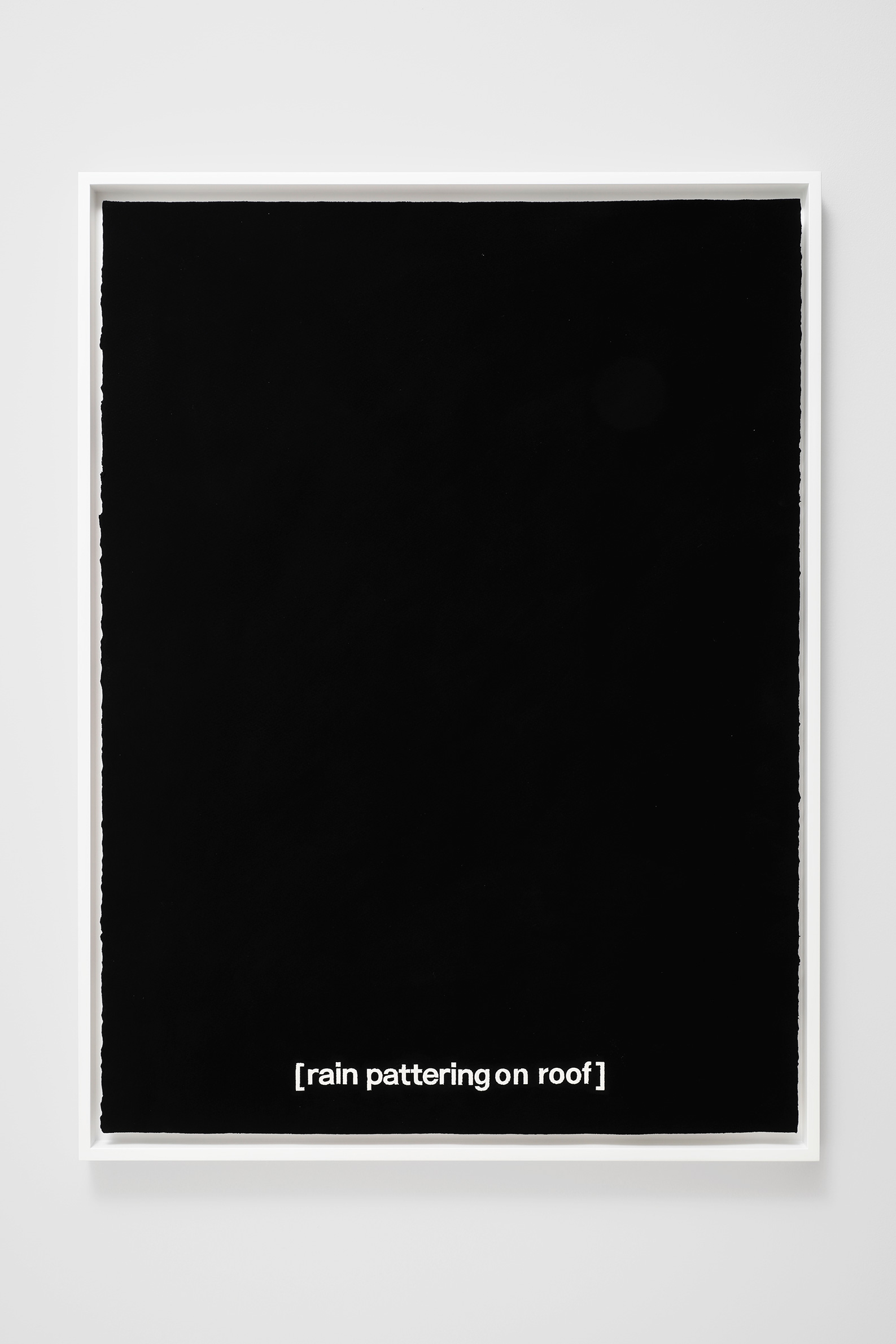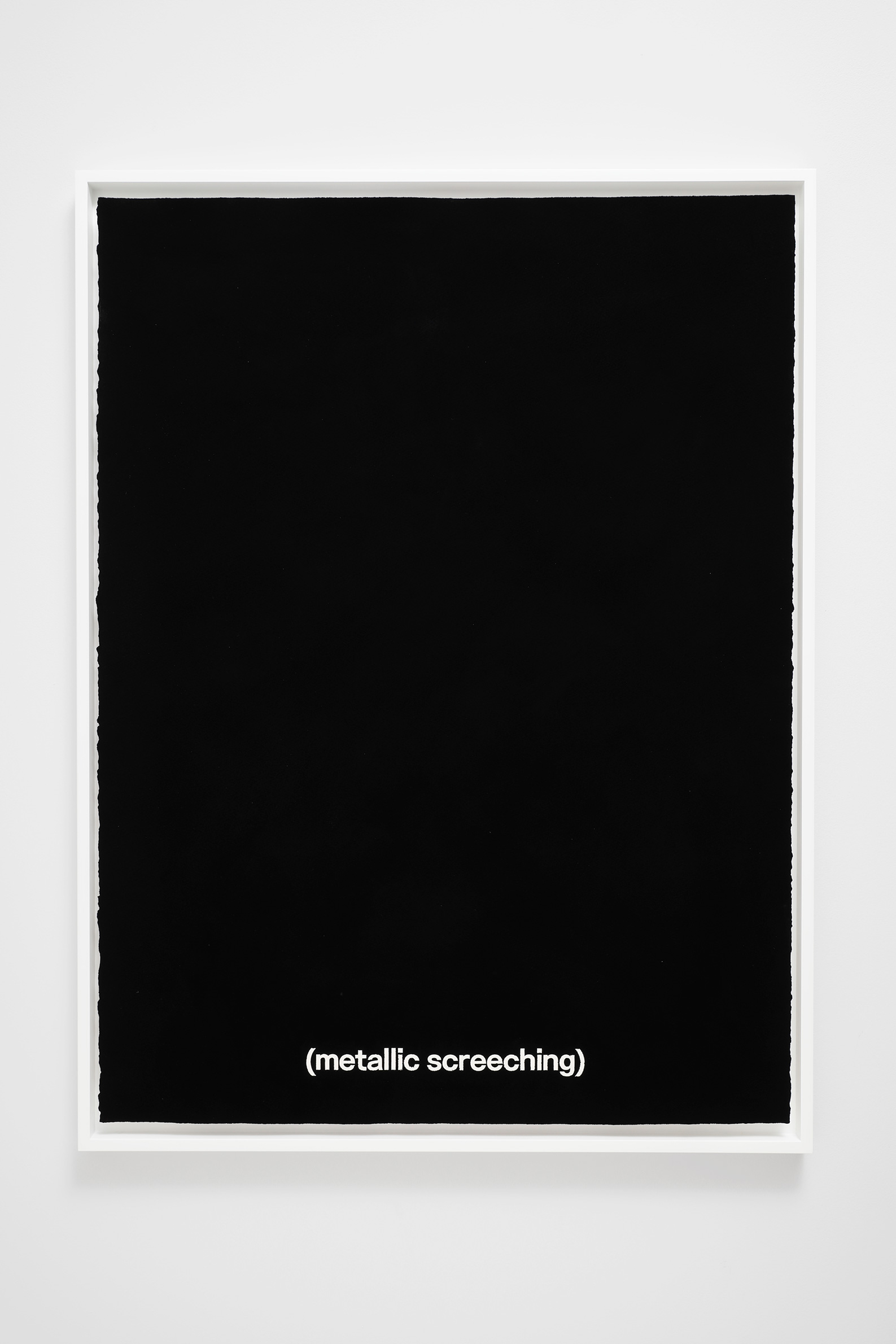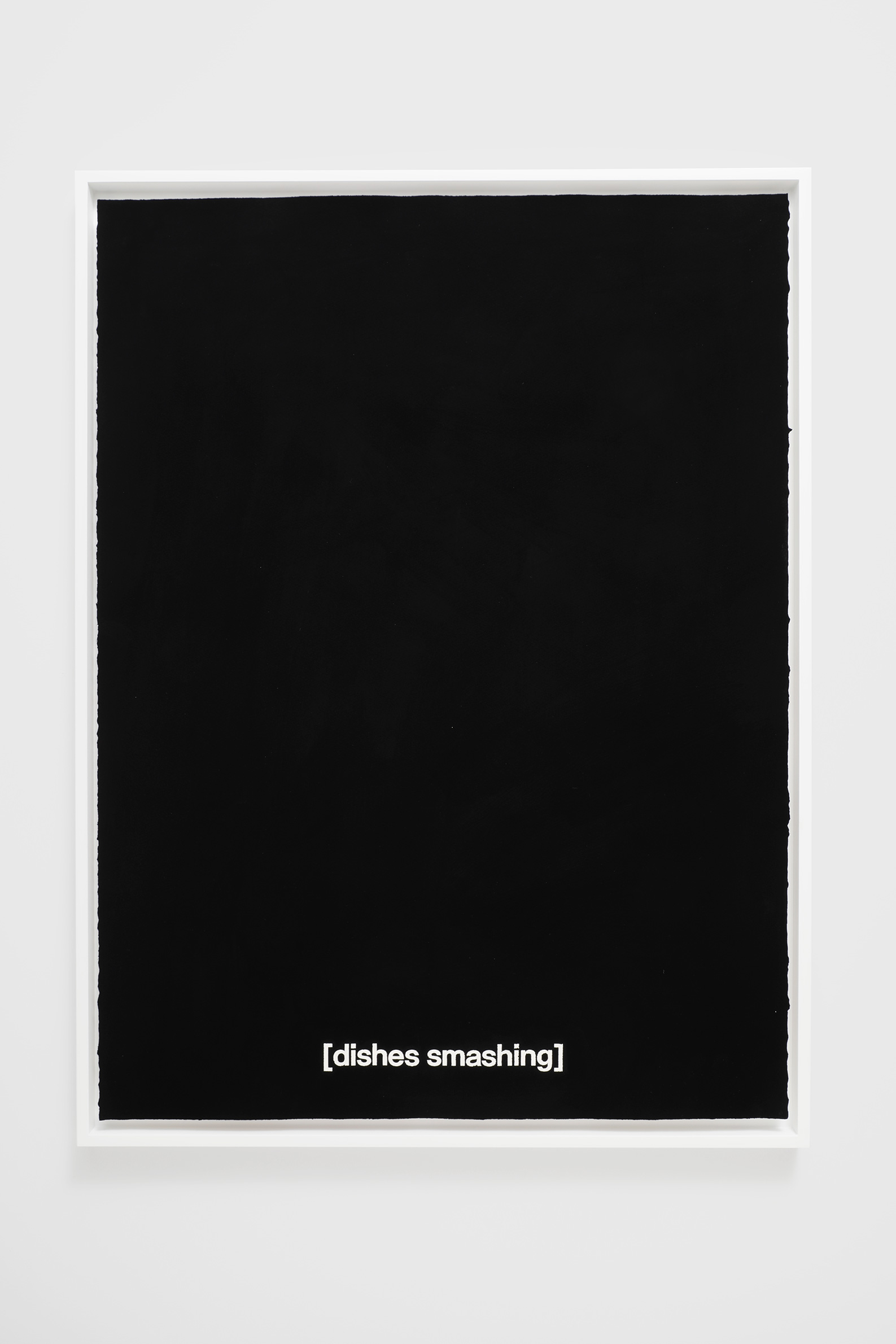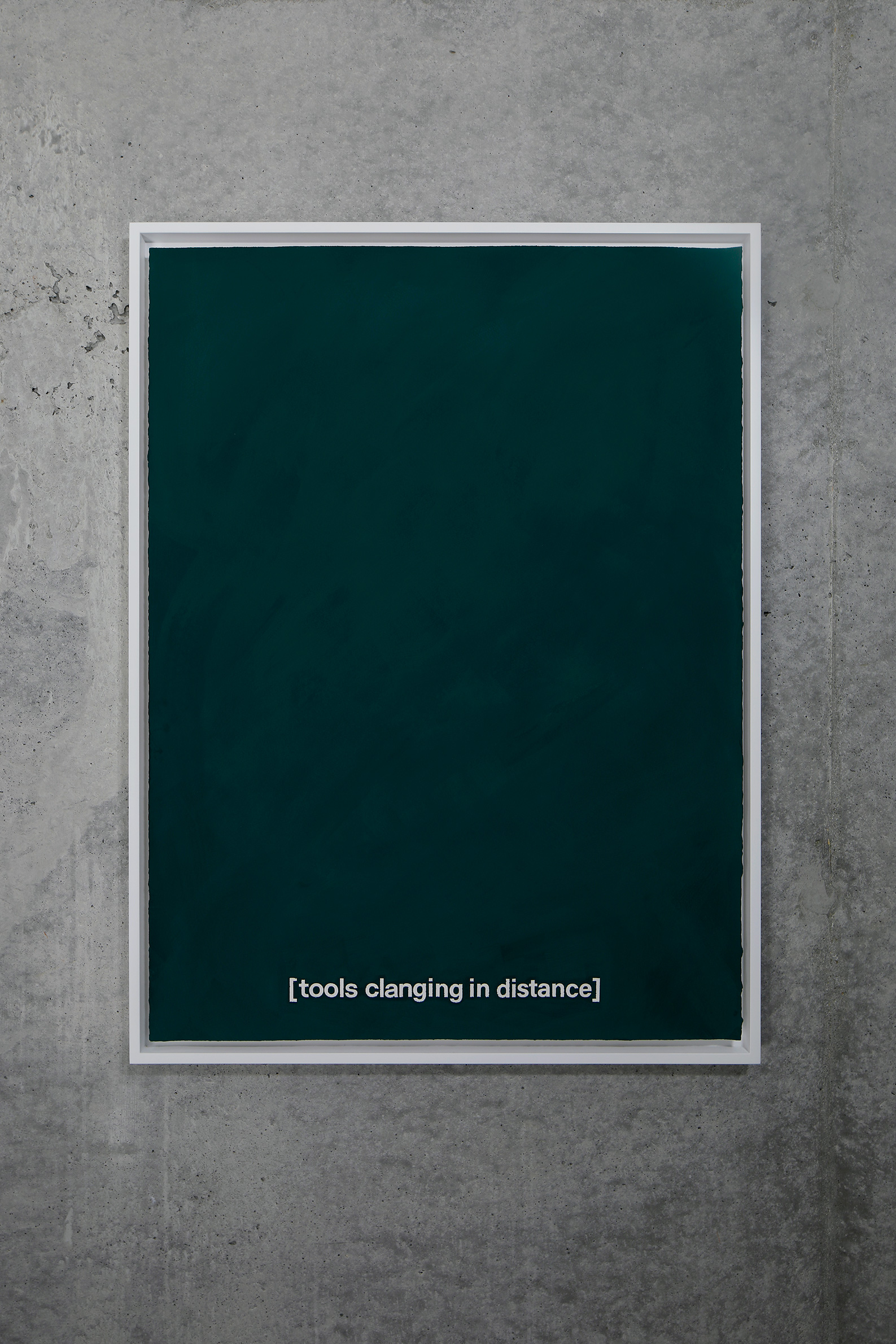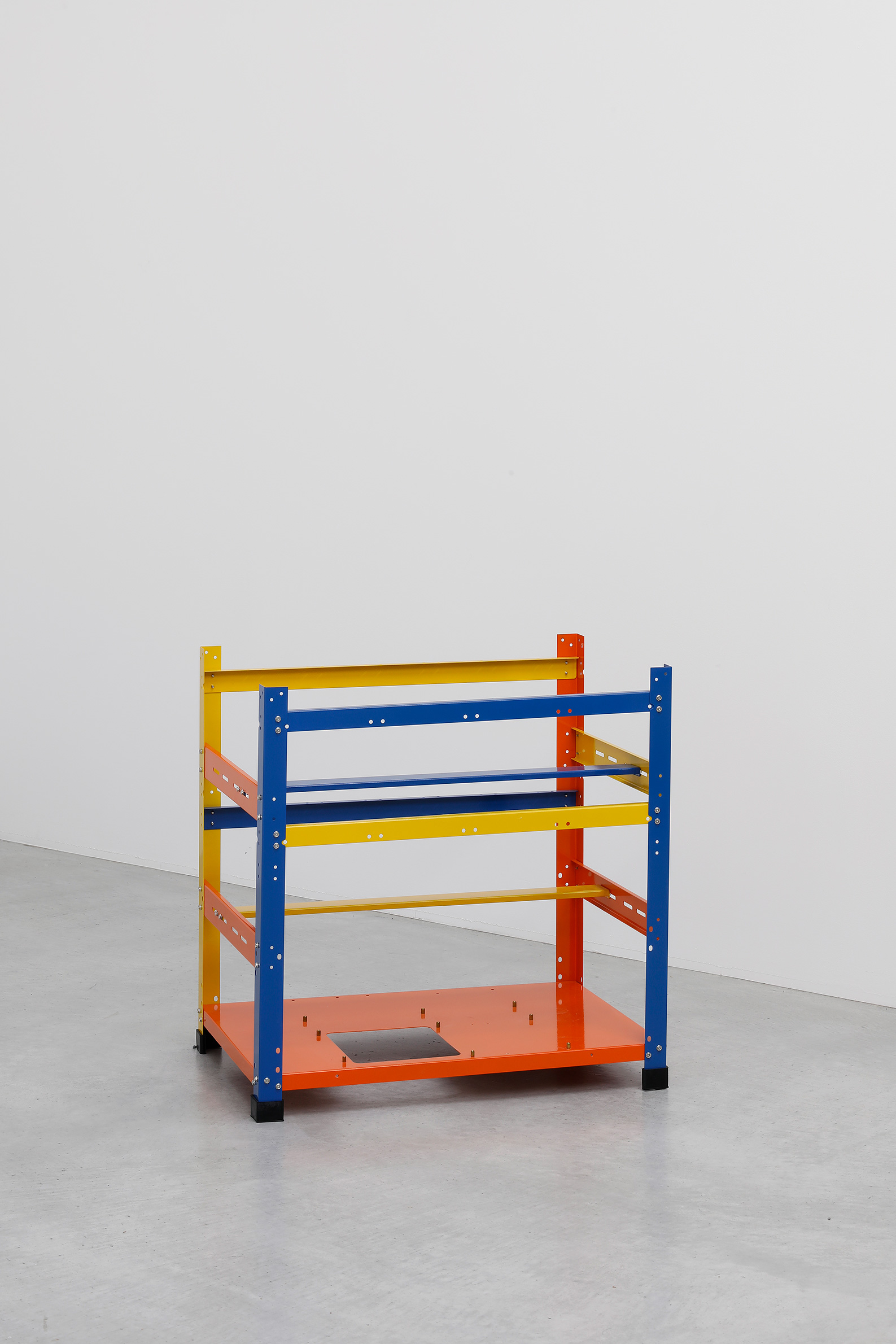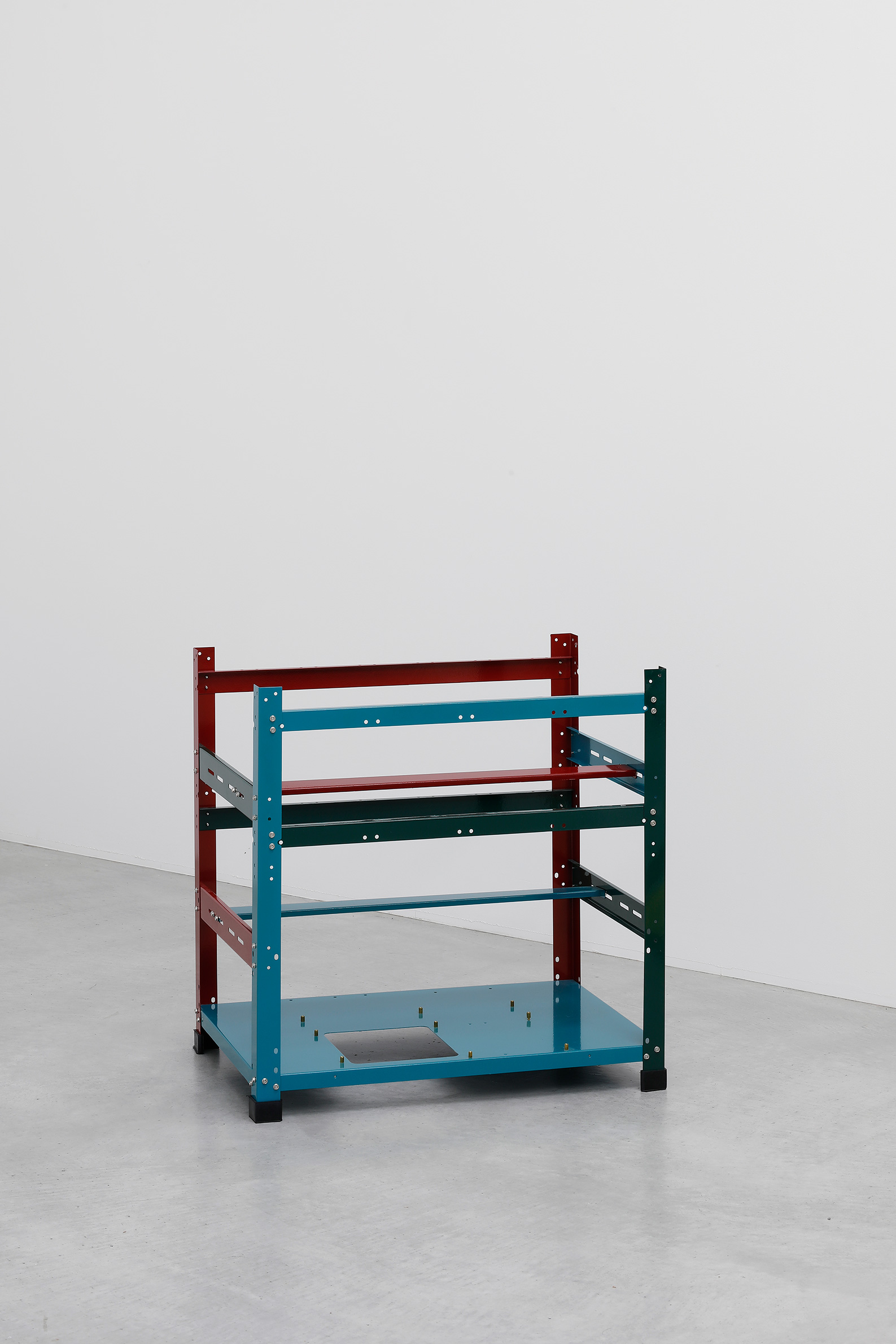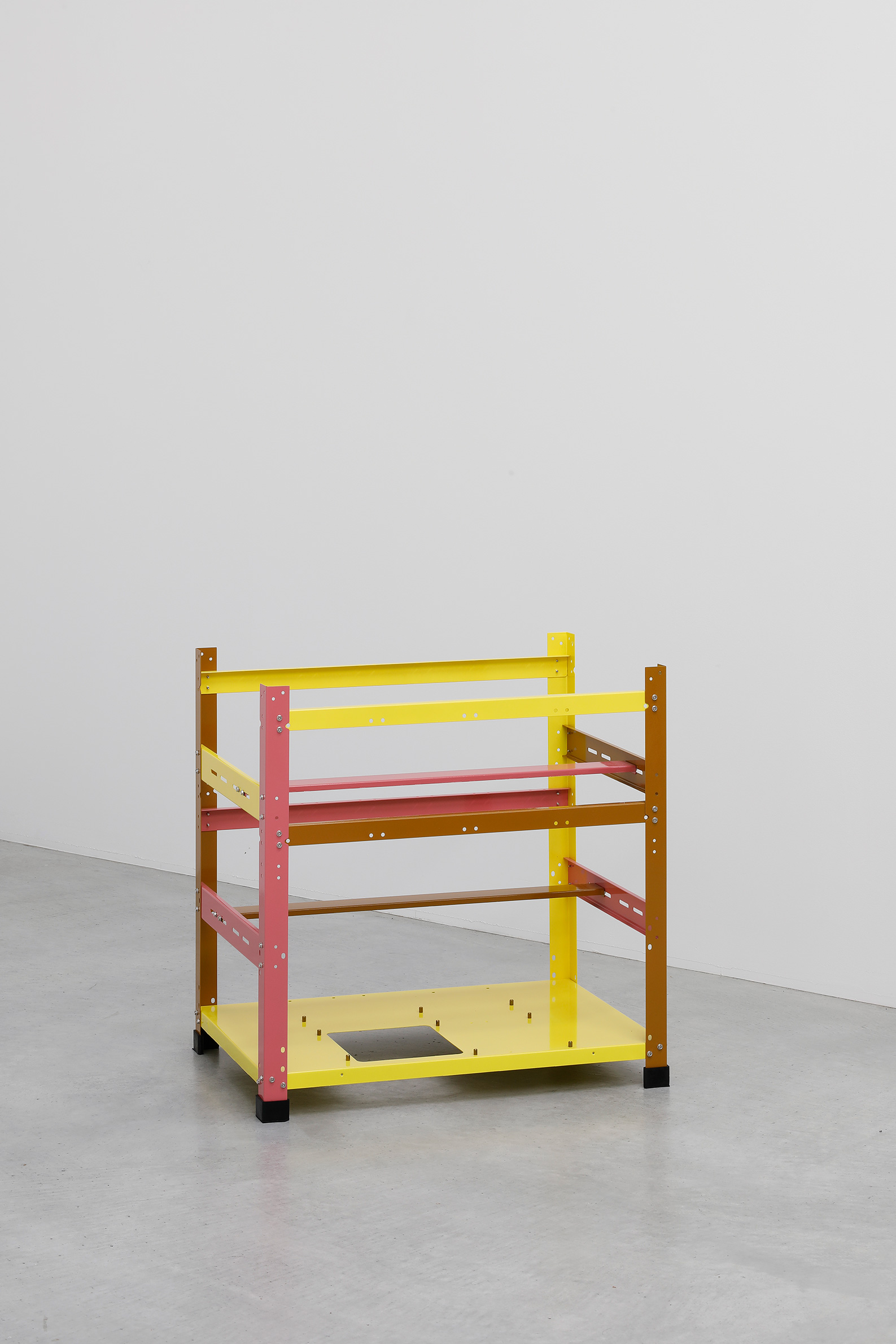“Marching Footsteps”, 2024
Acrylic on canvas
220 x 180 cm
(87 x 71 inches)
“Foreboding String Instrumental”, 2024
Acrylic on canvas
220 x 180 cm
(87 x 71 inches)
“”Ride of the Valkyries” Continues”, 2024
Gouache on Arches paper
76 x 56 cm
(30 x 22 inches)
“Music Cuts Off”, 2024
Gouache on Arches paper
76 x 56 cm
(30 x 22 inches)
“Neon Crackling, Man Shouting”, 2024
Gouache on Arches paper
76 x 56 cm
(30 x 22 inches)
“Droning”, 2024
Gouache on Arches paper
76 x 56 cm
(30 x 22 inches)
“Retching”, 2024
Gouache on Arches paper
76 x 56 cm
(30 x 22 inches)
“Monks Chanting”, 2024
Gouache on Arches paper
76 x 56 cm
(30 x 22 inches)
“Rain Pattering on Roof”, 2024
Gouache on Arches paper
76 x 56 cm
(30 x 22 inches)
“Metallic Screeching”, 2024
Gouache on Arches paper
76 x 56 cm
(30 x 22 inches)
“Dishes Smashing”, 2024
Gouache on Arches paper
76 x 56 cm
(30 x 22 inches)
“Crickets Chirping”, 2024
Gouache on Arches paper
76 x 56 cm
(30 x 22 inches)
“Tools Clanging in Distance”, 2024
Gouache on Arches paper
76 x 56 cm
(30 x 22 inches)
Mining Rig (RAL 1004 Golden Yellow, RAL 2009 Traffic Orange, RAL 5029 Capri Blue), 2024
Powder coated steel, hardware, rubber
53 x 36 x 53 cm
(21 x 14 x 21 inches)
Mining Rig (RAL 6005 Moss Green, RAL 5021 Water Blue, RAL 3003 Ruby Red), 2024
Powder coated steel, hardware, rubber
53 x 36 x 53 cm
(21 x 14 x 21 inches)
Mining Rig (RAL 1018 Zinc Yellow, RAL 8001 Ochre Brown, RAL 3014 Antique Pink), 2024
Powder coated steel, hardware, rubber
53 x 36 x 53 cm
(21 x 14 x 21 inches)
OSCAAR MOULIGNE is pleased to announce a solo exhibition by Gardar Eide Einarsson, entitled “Ride of the Valkyries” Continues, on view from September 7 until November 23, 2024. The exhibition will present a body of recent paintings and sculptures for the first time.
Einarsson is known for his works that examine the complex relationships and hierarchies of authority existing within social, political, and economic structures. Across a multitude of genres—from painting, sculpture, collage, silkscreen, and installation—and with various approaches including appropriation, assemblage, and abstraction of preexisting images, he constructs unsettling narratives that explore how and when individuals are driven to question the establishment. By examining and dissecting cultures, histories, identities, and the relationships between them, Einarsson addresses universal fears and conflicts that lie hidden or suppressed beneath the surface of the seemingly mundane everyday.
Often found in the artist’s work are visual signs and symbols taken from a variety of sources ranging from popular culture to political iconography to utopian ideologies and subcultures. By decontextualizing the images or objects, Einarsson makes them virtually devoid of their original meaning, creating works that are sophisticated, coded expressions—typically with elements of cynicism and humor—dually referencing the exercise of power and resistance to such. This imagery is combined with a formal vocabulary of Minimalism and geometric abstraction, often through a single color or rigorous black-and-white, as well as other references to art history such as the readymade, Pop Art, and Conceptual Art of the 1960s and ’70s.
In the paintings and works on paper on view in the exhibition, the source material Einarsson has used is closed-captioning text from various films and TV programs ranging in genre from war to science fiction to stand up comedy. These phrases, originally referring to vocal gestures, sounds, background noise, and musical cues on screen, are taken out of their context and placed onto a monochromatic black field. In doing so, Einarsson creates a void where visual imagery is missing, leaving the viewer to engage with nuances of intense emotional and psychological situations experienced through written language. While some are poetic descriptions as if to depict a calm before the storm, others comprise prophetic narratives that serve as a catalyst for notions of paranoia, psychoanalysis, and the unknown.
Also on view is an installation of readymade sculptures of Bitcoin mining rigs—steel-frame devices no longer prevalent in use—that have been powdercoated in a palette of RAL colors (a German color chart which enumerates colors for industry and commerce), taken from sketches found in the notebooks of Donald Judd. Demonstrating a contemplative contrast to the monochromatic paintings in the exhibition, Einarsson’s multicolored sculptures contain both formal and conceptual references to Minimalism and its use of outmoded relics of industrial production. In exploring the ideological and once-utopian era of cryptocurrency, Einarsson’s new works bring attention to the extreme velocity of technological obsolescence in contemporary society, silently alluding to an uncertain present and the fundamental upheaval of systems of control.
About the artist
Gardar Eide Einarsson was born in Oslo, Norway in 1976 and currently lives and works in Tokyo. He received his education from the National Academy of Fine Art in Bergen, Norway; Städelschule in Frankfurt am Main, Germany; Whitney Independent Study Program in New York; and Cooper Union School of Architecture in New York.
Einarsson’s work has been widely exhibited in solo and group exhibitions worldwide, including solo museum exhibitions at ARoS Aarhus Kunstmuseum; Astrup-Fearnley Museum in Oslo; Bergen Kunsthall; Bonniers Konsthall in Stockholm; Centre d’Art Contemporain in Geneva; the Contemporary Art Museum St. Louis; The Fridericianum in Kassel; Kunstverein Frankfurt; The Modern Art Museum in Fort Worth; and the Reykjavik Art Museum. The artist has also participated in the Whitney Biennial, the Istanbul Biennial, and the Sydney Biennial, among others.
Einarsson’s work is represented in a number of public collections including the Museum of Modern Art (MoMA), New York; Los Angeles County Museum of Art (LACMA), Los Angeles; Los Angeles Museum of Contemporary Art (LA MoCA), Los Angeles; San Francisco Museum of Modern Art (SFMoMA), San Francisco; Berkeley Art Museum, Berkeley, CA; Museum for Moderne Kunst Frankfurt (MMK), Moderna Museet, Stockholm; Malmö Art Museum, Malmö; Astrup Fearnley Museum of Modern Art, Oslo and the Norwegian National Museum of Art, Oslo.
OSCAAR MOULIGNE はこのたびガーダー・アイダ・アイナーソン個展 “Ride of the Valkyries” Continues (『「ワルキューレの騎行」は続く』)を2024年9月7日から11月23日まで開催いたします。出品されるペインティングとスカルプチャーはいずれも初公開となります。
アイナーソンは社会・政治・経済構造の内部に存在する複雑な権威の関係やヒエラルキーを検討する作品で知られています。ペインティングからスカルプチャー、コラージュ、シルクスクリーン、インスタレーションに及ぶ多様なジャンルを横断し、アプロプリエーション、アッサンブラージュ、既存のイメージの抽象化といったアプローチを駆使しながら、アイナーソンは見る者を動揺させるようなナラティヴを組み立て、個々の人間が既成権力に疑問を投げかけることになるのはどのような状況においてかを探ります。さまざまな文化、歴史、アイデンティティ、さらにそれらのあいだの関係を検討し解剖するなかでアイナーソンが取り上げるのは、一見ごくありふれた日常の表面の水面下には、いたるところに恐怖や葛藤が隠されている、あるいは押し込められているという事実です。
アイナーソンの作品には、ポピュラーカルチャーから政治的図像群、ユートピア志向のイデオロギー、サブカルチャーに至る多彩なソースから取り出した視覚記号やシンボルが多く見られます。イメージやオブジェクトを本来のコンテクストから引き剥がすことでアイナーソンは、それらがもともと備えていた意味をほぼ完全に抜き去ってしまいます。結果として創り出される作品群は、洗練されているとともに──しばしばシニシズムやユーモアを添えて──暗号化された表現となっており、権力の行使とそれに対する抵抗を同時に指し示します。このようなイメージ群は、しばしば単色または白黒に厳しく限定された画面上でミニマリズムや幾何学的抽象などの形式言語と組み合わされ、合わせてレディメイド、1960年代から70年代にかけてのポップアート、コンセプチュアルアートといった美術史が参照されます。
本展に出品されるペインティングや紙作品の場合、アイナーソンは映画や戦争からSF、スタンダップコメディに至るTV番組に付されていたクローズドキャプション(字幕)を素材に用いています。声が示す仕草、音、背景のノイズ、BGMなどといったフレーズを本来のコンテクストから抜き取り、黒一色の画面上に置くことでアイナーソンは、ひとつの空虚を創り出します。そこに視覚イメージは不在であり、見る者は書かれた言葉を通じて、強烈な情動や心理を掻き立てる状況を経験し、さまざまなニュアンスをそこに読み取るほかありません。嵐の前の静けさを描写するかのような詩的記述がある一方で、予言めいたナラティヴも見られ、パラノイア、精神分析、未知といった観念を喚起する役割を果たします。
今回は、ビットコインマイニング・リグ──機器を収めるスチール製フレームで、現在ではあまり用いられなくなった──を、ドナルド・ジャッドがノートに描きとめていたスケッチから取ったRALカラーチャート(ドイツ発の工業・商業用色見本)にもとづいて粉体塗装したレディメイド・スカルプチャーのインスタレーションも展示されます。同時に出品されるペインティングに比べると一転して瞑想的なアイナーソンの多色スカルプチャーは、ミニマリズムを形とコンセプトの両面で参照し、ジャッドを始めとするミニマリズムのアーティストたちが時代遅れの工業生産技術を利用していたことを踏まえています。当初はユートピア志向であった暗号通貨時代の背後に潜むイデオロギーを探究しつつアイナーソンの新作は、現代社会ではテクノロジーが極端なまでのスピードで古びていくという事実に注意を喚起し、さまざまな管理システムの現在が不確かであること、その基盤自体が揺らぎつつあることを、無言で仄めかしています。
About the artist
ガーダー・アイダ・アイナーソン Gardar Eide Einarsson
1976年ノルウェー、オスロ生。東京在住。ノルウェー国立美術アカデミー(ベルゲン)、シュテーデル美術大学(ドイツ、フランクフルト゠アム゠マイン)、ホイットニー・インディペンデント・プログラム(ニューヨーク)、クーパー・ユニオン建築学校(ニューヨーク)に学ぶ。
世界各地で個展・グループ展多数。個展:アロス・オーフス美術館(デンマーク)、アストラップ・ファーンリ現代美術館(オスロ)、ベルゲン・クンストハル、ボンニエルス・コンストハル(ストックホルム)、ジュネーヴ現代美術センター、セントルイス現代美術館、フリーデリチアヌム(カッセル)、フランクフルト・クンストフェライン、フォートワース近代美術館、レイキャヴィーク美術館など。ホイットニー・ビエンナーレ、イスタンブール・ビエンナーレ、シドニー・ビエンナーレなどにも参加。
パブリック・コレクション:ニューヨーク近代美術館(MoMA)、ロサンゼルス郡立美術館(LACMA)、ロサンゼルス現代美術館(LA MoCA)、サンフランシスコ近代美術館、バークリー美術館(カリフォルニア州)、フランクフルト近代美術館(MMK)、ストックホルム近代美術館、マルメ近代美術館、アストラップ・ファーンリ現代美術館(オスロ)、ノルウェー国立美術館(オスロ)など。

